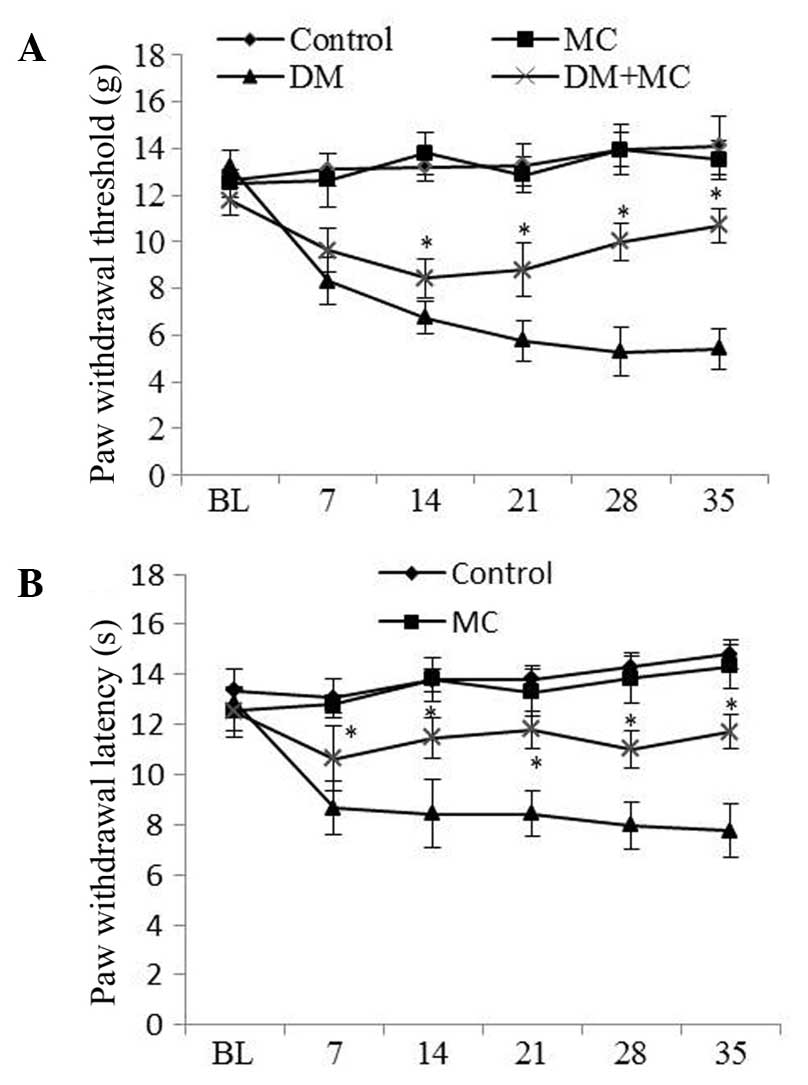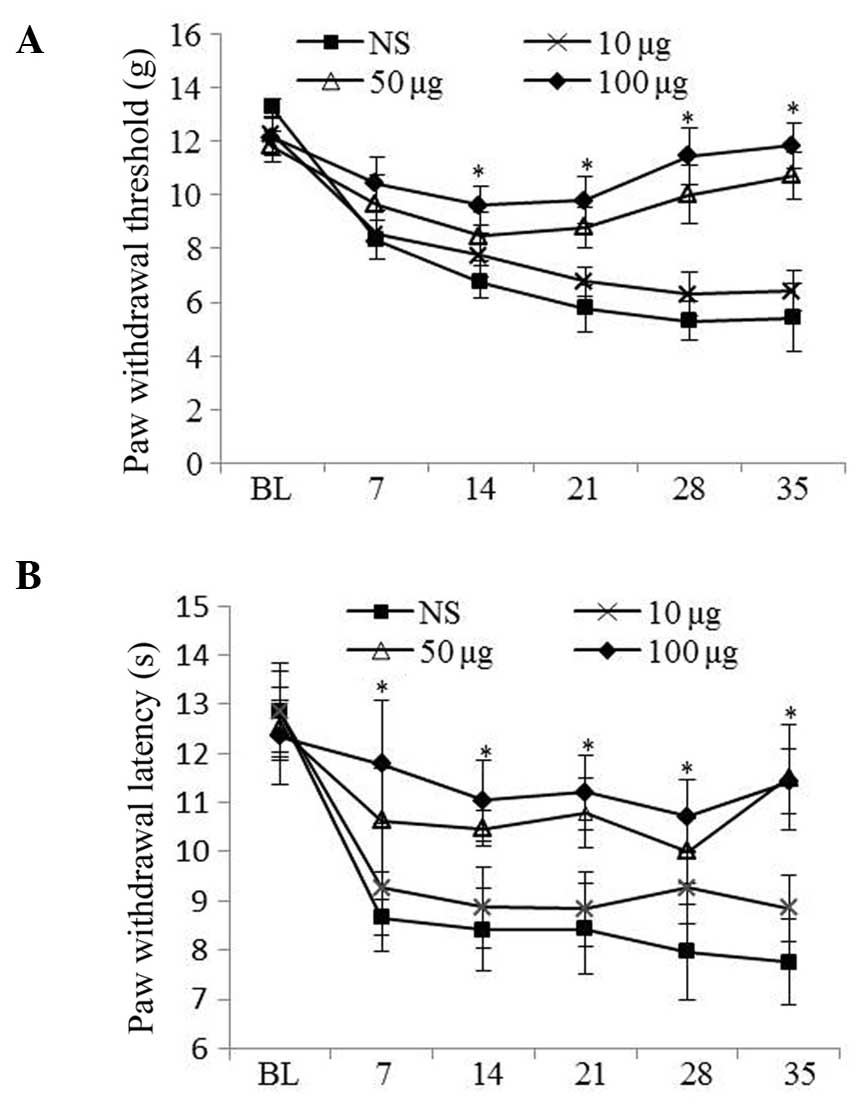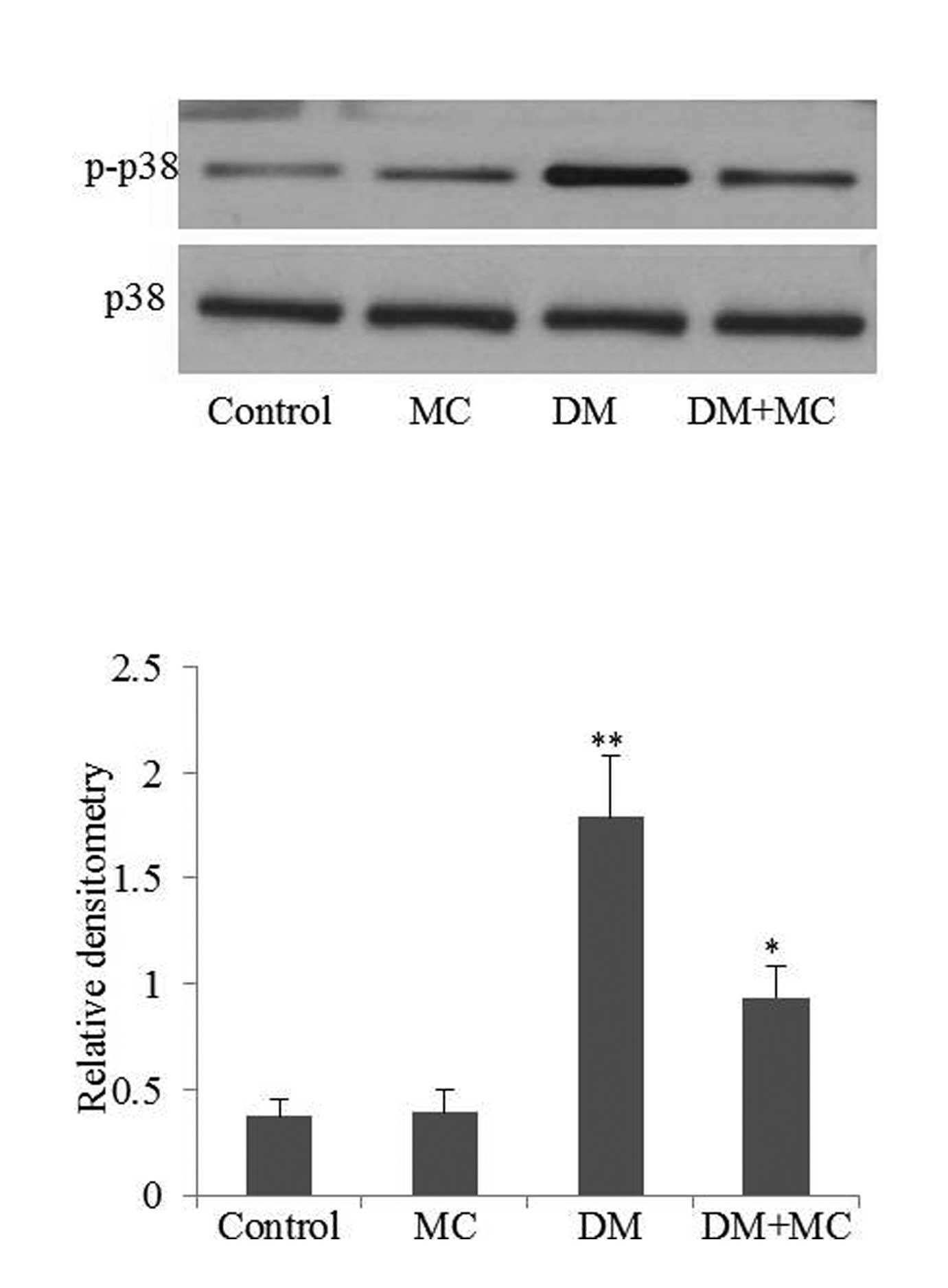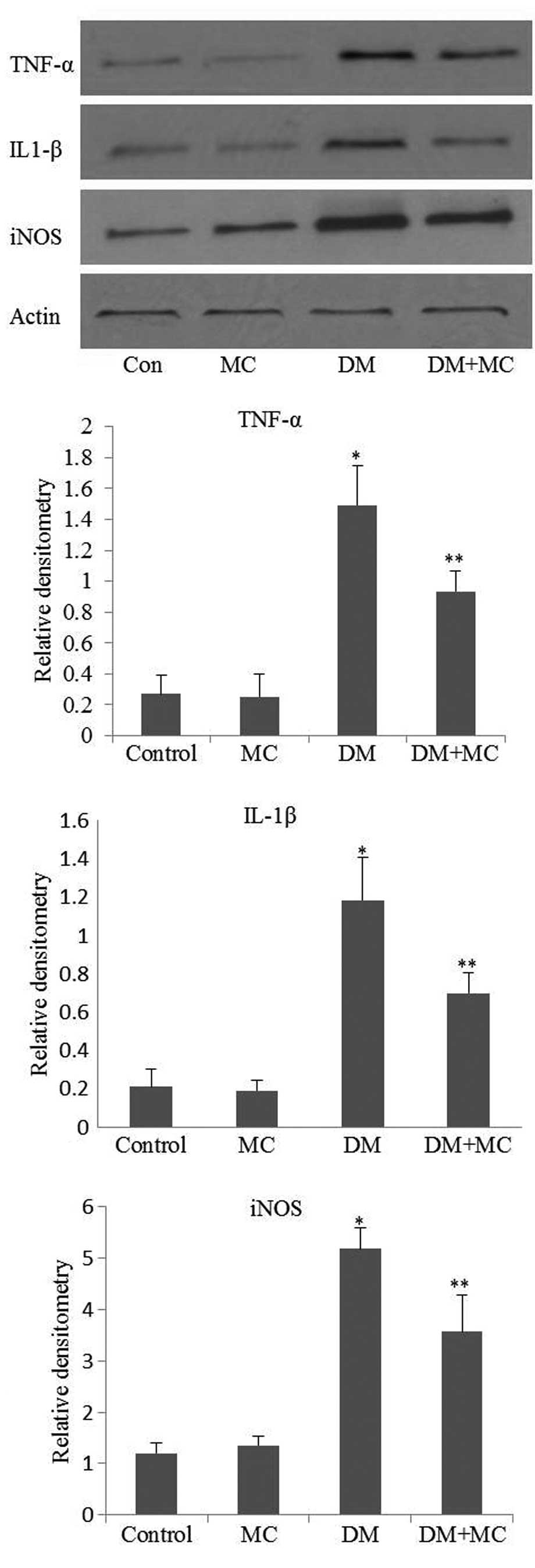Minocycline attenuates pain by inhibiting spinal microglia activation in diabetic rats
- Authors:
- Published online on: May 6, 2015 https://doi.org/10.3892/mmr.2015.3735
- Pages: 2677-2682
Abstract
Introduction
Diabetes mellitus is a group of metabolic diseases characterized by hyperglycemia as a result of insulin secretion and/or activity impairment. Diabetic neuropathy is a common complication that affects sensory neurons, motor neurons and the autonomic nervous system. Diabetic nerve pain is one of the most common symptoms of diabetic neuropathy and is characterized by spontaneous pain, hyperalgesia and paresthesias (1). The mechanisms underlying diabetic pain are complex and involve multiple mechanisms, including oxidative and nitrosative stress, immune system activation and mitochondrial dysfunction (2,3). Several lines of clinical and experimental evidence have indicated that neuroinflammation is an important factor in the process of peripheral and central diabetic neuropathy, which has been associated with the elevation of pro-inflammatory cytokines, including tumor necrosis factor-α (TNF-α) and interleukin-1β (IL-1β) (4–6).
Microglia, which are the predominant resident types of immune cells involved in the nervous system, mediate and regulate multiple inflammatory processes and are associated with the inflammatory changes underlying diabetic neuropathy (7). Minocycline is a tetracycline-derived antibiotic that exhibits anti-inflammatory properties in the central nervous system (8). It has been used in a number of animal models of neuroinflammation in which microglia are implicated. Studies using rat models of pain facilitation have demonstrated that minocycline treatment inhibits microglial activation and cytokine expression (9,10).
Activated microglia have been shown to cause or exacerbate diabetic pain. The effects of minocycline on pain in rats with streptozotocin (STZ)-induced diabetes were investigated in the present study.
Materials and methods
Animals
A total of 42 10 week-old male Sprague-Dawley rats (200–250 g) were provided by the Experimental Animal Center of the Fourth Military Medical University (license no. RD-2010-06). Animals were housed under standard laboratory conditions, maintained on a 12 h light-dark cycle with food and water ad libitum. The experimental protocols were approved by the Institutional Animal Ethics Committee of the Fourth Military Medical University (Xi’an, China).
Experimental diabetic model
Diabetes was induced in 30 rats by administering one dose of STZ (Sigma-Aldrich, St. Louis, MO, USA) prepared in citrate buffer (pH 4.4, 0.1 M; Abcam, Cambridge, MA, USA). Six rats were removed from the study, due to failure of induction. STZ (65-mg/kg) was injected intraperitoneally. Twelve age-matched control rats were administered an equal volume of citrate buffer. Forty-eight hours following the injection, diabetes was confirmed by collecting blood samples from the tail vein. Plasma glucose levels were estimated using a commercial blood glucose analyzer (Accusoft, Roche Diagnostics, Laval, QC, Canada). Rats with plasma glucose levels >300 mg/dl during fasting (12–16 h) were considered to be diabetic and included in the study. Body weight and plasma glucose levels were recorded twice per week for the duration of the study.
Intrathecal (IT) catheter implantation and drug administration
IT catheters were implanted as described by LoPachin (11). Rats were anesthetized using isoflurane (2% in oxygen; RWD Life Science, Shenzhen, China). The occipital muscles were separated, and the cisternal membrane was exposed. IT polyethylene catheters (catalogue no. PE-10; outer diameter 0.5 mm, inner diameter 0.25-mm, BD Intramedic™ Polyethylene Tubing; BD Sciences, Franklin Lakes, NJ, USA) were inserted via an incision in the cisterna magna and advanced caudally 7–8 cm deep to the lumbar enlargement of the spinal cord. The incision site was closed in layers, and the catheter was fixed firmly under the skin and heat-sealed. Animals recovered for 3 days until further treatment. Rats that exhibited no signs of motor deficiency (hind limb paralysis and stiffness) were used in the study. Drugs were injected via the IT catheter with an initial volume of 10 μl STZ followed by 10 μl of saline solution.
The rats with STZ-induced diabetes and control rats were treated with 10, 50 or 100 μg/kg minocycline (Sigma-Aldrich) dissolved in 10 μl saline, or saline vehicle injection. IT administration of the drug or vehicle was initiated 4 days following STZ injection and was repeated twice daily at consistent times for the following 31 days. Paw withdrawal threshold (PWT) and paw withdrawal latency (PWL) were measured 1 h prior to minocycline or saline administration.
Assessment of mechanical allodynia
PWT was measured using an up-down testing paradigm. Rats were placed in cages with mesh floors and covered with transparent plastic boxes. They acclimatized to their surroundings for a minimum of 30 min in a temperature-controlled room (25°C) prior to being tested. Von Frey hairs (Stoelting, Kiel, WI, USA) in log increments of force (0.38, 0.57, 1.23, 1.83, 3.66, 5.93, 9.13, and 13.1 g) were applied for 4–6 sec to the region between the foot pads in the plantar surface of the hind paw. Abrupt paw withdrawal, licking and shaking were interpreted as positive responses.
Assessment of thermal hyperalgesia
In order to assess nociceptive responses to thermal stimuli, the rats were placed in plexiglass chambers (18 × 8 × 8 cm; RWD Life Science) and radiant heat (49°C), produced by an analgesia meter (cat. no. 390G; IITC Life Science, Woodland Hills, CA, USA), was applied to the plantar surface of the test paw. A cut-off time of 20 sec was used in order to prevent tissue damage. PWL from the radiant heat was recorded using a plantar test (Hargreaves’ method) analgesia meter. Abrupt paw withdrawal, licking and shaking were interpreted as positive responses.
Western blot analysis
Rats were anesthetized using 5% isoflurane and then decapitated. Lumbar spinal cords were dissected at L4-L6. Samples were homogenized in modified radioimmunopreciptation assay buffer (50 mM Tris-HCl, pH 7.4; 1% nonyl phenoxypolyethoxylethanol, 1 mM ethylenediaminetetraacetic acid and 150 mM NaCl) supplemented with protease inhibitor cocktail (Sigma-Aldrich) diluted 1:10 and 2 mM phenylmethanesulfonylfluoride, 2 mM NaF and phosphatase inhibitor cocktail I and II were added (Sigma-Aldrich). Lysates were then centrifuged at 4°C for 20 min at 12,000 × g. The supernatants were collected and total protein concentration was measured using a bicinchoninic acid kit (Pierce Biotechnology, Inc., Rockford, IL, USA). Protein extracts were separated using SDS-PAGE in 7% Tris-HCl gels (Bio-Rad Laboratories, Hercules, CA, USA) and transferred to polyvinylidene difluoridemembranes (EMD Millipore, Billerica, MA, USA), which were subsequently blocked using blocking solution [5% dry non-fat milk in tris-buffered saline with 0.1% Tween 20® (TBST)] for 1 h. Membranes were incubated with rabbit anti-Iba-1 antibody (1:1,000; cat. no. 016-20001; Wako Chemicals USA, Inc., Richmond, VA, USA), rabbit anti-OX-42 antibody (1:500; cat. no. RA25012; Neuromics, Edina, MN, USA), rabbit anti-phospho-p38 MAPK antibody (1:500; cat. no. 9212; Cell Signaling Technology, Inc., Danvers, MA, USA), mouse anti-p38 mitogen-activated protein kinase (MAPK) antibody (1:500; cat. no. ab31828; Abcam), rabbit anti-TNF-α antibody (1:500; cat. no. 3707; Cell Signaling Technology, Inc.), rabbit anti-IL-1β antibody (1:5,000; cat. no. ab200478; Abcam), or rabbit anti-inducible nitric oxide synthase (iNOS) antibody (1:2,000; cat. no. PA3-030A; Thermo Fisher, Rockford, IL, USA) in blocking solution overnight at 4°C, washed in TBST and then incubated with horseradish peroxidase-conjugated anti-rabbit (cat. no. A0545) or anti-mouse (cat. no. A9044) immunoglobulin G (1:1,000; Sigma-Aldrich, St. Louis, MO, USA) for 1 h at room temperature. Membranes were then washed with TBST followed by TBS and developed using enhanced chemiluminescence detection reagent (GE Healthcare, Bio-Sciences, Pittsburgh, PA, USA) prior to film exposure (Kodak, Rochester, NY, USA) a number of times. Membranes were reprobed with an antibody to β-actin for use as an internal loading control.
Statistical analysis
Quantitative data are expressed as the mean ± standard error of the mean. Statistical significance among experimental groups was determined using one-way or two-way analysis of variance with Bonferroni multiple-comparison post-hoc analysis. P<0.05 was considered to indicate a statistically significant difference. Statistical comparisons were computed using SigmaPlot 12.0 software (Systat Software, Inc., Chicago, IL, USA).
Results
Rats
Within the first week following STZ injection, rats demonstrated signs of diabetes, including weight loss, polydipsia and polyuria. Two weeks following STZ injection, rats exhibiting a glucose level >300 mg/dl were included in the diabetic group. Rats with STZ-induced diabetes exhibited significantly increased blood glucose levels (473±28.6 mg/dl) compared with the control group (121±12.7 mg/dl) and reduced body weight (195±12.2 g) compared with the control group (293±12.8 g; Table I).
PWT values were significantly lower in diabetic rats than that in control rats, suggesting the presence of mechanical allodynia in diabetic rats. However, allodynia was reduced in diabetic rats treated with minocycline compared with those treated with vehicle (Fig. 1A). The threshold for thermal hyperalgesia was significantly decreased following STZ-injection compared with that in control rats. Similar to mechanical allodynia, hyperalgesia was significantly lower in diabetic rats treated with minocycline than in those treated with saline vehicle (Fig. 1B). Minocycline treatment attenuated mechanical allodynia and hyperalgesia in a dose-dependent manner. Minocycline treatment (50 and 100 μg) was shown to reduce diabetic pain in diabetic rats compared with those treated with vehicle (P<0.05; Fig. 2A and 2B).
OX-42 and Iba-1 expression is upregulated in activated microglia
In order to assess the effects of minocycline on microglial activation in diabetic rats, OX-42 and Iba-1 expression was measured using western blotting. Western blotting suggested that OX-42 and Iba-1 expression levels were upregulated in diabetic rats compared with control rats. However, their expression levels in the spinal cord decreased significantly following minocycline treatment of diabetic rats compared with those treated with saline vehicle (Fig. 3; P<0.05). The p38 MAPK signaling pathway is involved in microglial activation and cytokine production. Therefore, phospho-p38 MAPK levels were analyzed in the present study. The results demonstrated that phospho-p38 MAPK expression in diabetic rats was significantly higher compared with the control group (Fig. 4; P<0.05). However, the level of phospho-p38 MAPK expression decreased following minocycline treatment. The results suggested that microglia were activated in diabetic rats, while minocycline treatment of diabetic rats inhibited microglial activation.
Activated microglia secrete proinflammatory cytokines and iNOS, which are involved in pain hypersensitivity
The expression of TNF-α, IL-1β and iNOS in the spinal cords of diabetic rats was significantly higher compared with that in the control group. However, following minocycline treatment, the expression levels of TNF-α, IL-1β and iNOS were significantly lower in diabetic rats compared with those of the saline vehicle-treated group (Fig. 5; P<0.05). Proinflammatory cytokines and iNOS expression was not completely inhibited in minocycline-treated diabetic rats compared with saline vehicle-treated diabetic rats. This may be explained by the presence of astrocytes, which are not inhibited by minocycline and may contribute to the expression of proinflammatory cytokines and iNOS (12).
Discussion
Inflammation is involved in the progression of diabetic neuropathic complications. Proinflammatory cytokines, such as TNF-α and IL-1β have been found to exhibit increased expression in diabetic patients (13). In chronic hyperglycemia, proinflammatory cytokines and reactive oxygen species (ROS) infiltrate vascular tissues and activate microglia. Recent studies have shown that microglia activation is associated with the initiation and maintenance of neuropathic pain (14,15). Activated microglia release a number of neurotoxins that further enhance microglial proliferation and activation (10). Activated microglia excrete TNF-α and IL-1β. In addition, via the expression of iNOS, activated microglia produce toxic mediators, such as ROS and nitric oxide (NO). Proinflammatory cytokines and chemokines are associated with hyperalgesia (5).
TNF-α expression induces the phosphorylation of c-Jun N-terminal kinase 1 and activates nuclear factor κB (NF-κB), leading to chemokine (C-C motif) ligand 2 (CCL2) release. CCL2 then acts on C-C chemokine receptor type 2 (CCR2) receptors on neurons and interacts positively with neuronal N-methyl-D-aspartate (NMDA) and α-Amino-3-hydroxy-5 -methyl-4-isoxazolepropionic acid (AMPA) receptors (16). In the rostral ventromedial medulla, which is responsible for maintaining chronic neuropathic pain, TNF-α is induced following nerve injury and facilitates NMDA receptor phosphorylation (17). TNF-α also stimulates phosphorylation of the glutamate A1 subunit of the AMPA receptor and promotes its trafficking to the membrane in dorsal horn neurons (9,18).
IL-1β is another proinflammatory cytokine involved in pain hypersensitivity. The release of IL-1β is mediated by chemokine (C-X3-C motif) ligand 1 signaling and p38 MAPK activation, and is dependent on adenosine triphosphate. Following spinal nerve injury or inflammation, pro-IL-1β is cleaved by matrix metalloproteinase-9 in microglia. IL-1β is an important messenger between glial cells and neurons. Activation of the IL-1 receptor causes it to colocalize with NMDA receptors, facilitating NMDA receptor phosphorylation, which induces changes in synaptic strength and results in hyperalgesic behavior (17,19). However, IL-1β may also function in an NMDA receptor-independent manner (20).
ROS are associated with the development of persistent pain that results from nerve injury or inflammatory insult (21). Studies have shown that ROS in the spinal cord may induce pain by reducing the inhibitory effect of γ-aminobutyric acid on substantia gelatinosa neurons that are involved in pain transmission (22). High NO is associated with diabetic neuropathic pain (23). The production of NO occurs via increased iNOS activity following chronic inflammation in diabetic patients. There is evidence to suggest that there is a reciprocal correlation between NO and prostaglandin (PG) biosynthetic pathways (24). NO directly influences cyclooxygenase expression and PG biosynthesis (23).
In the present study, the PWT and PWL in diabetic rats were markedly lower compared with control rats. Spinal cord expression levels of OX-42, Iba-1 and phospho-p38 MAPK were elevated in diabetic rats compared with those in control rats. Microglia activation produced additional proinflammatory cytokines and toxic mediators, which are involved in diabetic pain. When treated with minocycline, diabetic rats exhibited reduced mechanical allodynia and thermal hyperalgesia compared with those treated with saline vehicle. The inhibition of microglial activation was confirmed by a decrease in the expression of microglia markers and proinflammatory cytokines. The results of the present study also demonstrated that the expression of proinflammatory cytokines and iNOS could not be completely blocked by treatment with minocycline. This was partly because astrocytes, which cannot be inhibited by minocycline, also contribute to the expression of proinflammatory cytokines and iNOS (12). These results suggested that minocycline may attenuate diabetic pain by inhibiting microglial activity.
The mechanisms underlying the influence of minocycline on diabetic rats are currently unclear. However, recent studies have suggested that minocycline inhibits MAPK- and NF-κB-dependent signaling pathways in primary microglia and microglial cell cultures compared with controls (13). Furthermore, minocycline suppresses microglial expression of OX-42 and major histocompatibility complex class II in rat brains via a protein kinase C-dependent mechanism (15).
In conclusion, the results of the present study indicated a potential effect of minocycline for the treatment of diabetic hypersensitivity. Minocycline may inhibit spinal microglial activation and attenuate diabetic pain in diabetic rats. Therefore, further investigation into the use of microglial inhibition in the treatment of incurable diabetic pain may be beneficial.
Acknowledgments
The present study was supported by the National Natural Science Foundation of China (grant nos. 81100816 and 81000563).
References
|
Yagihashi S, Yamagishi S and Wada R: Pathology and pathogenetic mechanisms of diabetic neuropathy: Correlation with clinical signs and symptoms. Diabetes Res Clin Pract. 77(Suppl 1): S184–S189. 2007. View Article : Google Scholar : PubMed/NCBI | |
|
Green CJ, Pedersen M, Pedersen BK and Scheele C: Elevated NF-κB activation is conserved in human myocytes cultured from obese type 2 diabetic patients and attenuated by AMP-activated protein kinase. Diabetes. 60:2810–2819. 2011. View Article : Google Scholar : PubMed/NCBI | |
|
Newsholme P, Gaudel C and Krause M: Mitochondria and diabetes. An intriguing pathogenetic role. Adv Exp Med Biol. 942:235–247. 2012.PubMed/NCBI | |
|
Zhang YL, Xu JM, Zhou P, Zhong XL and Dai RP: Distinct activation of tumor necrosis factor-α and interleukin-6 in the spinal cord after surgical incision in rats. Mol Med Rep. 5:1423–1427. 2012.PubMed/NCBI | |
|
Ren K and Dubner R: Interactions between the immune and nervous systems in pain. Nat Med. 16:1267–1276. 2010. View Article : Google Scholar : PubMed/NCBI | |
|
Jung WW, Kim HS, Shon JR, Lee M, Lee SH, Sul D, Na HS, Kim JH and Kim BJ: Intervertebral disc degeneration-induced expression of pain-related molecules: Glial cell-derived neurotropic factor as a key factor. J Neurosurg Anesthesiol. 23:329–334. 2011. View Article : Google Scholar : PubMed/NCBI | |
|
Prinz M, Tay TL, Wolf Y and Jung S: Microglia: Unique and common features with other tissue macrophages. Acta Neuropathol. 128:319–331. 2014. View Article : Google Scholar : PubMed/NCBI | |
|
Amin AR, Attur MG, Thakker GD, Patel PD, Vyas PR, Patel RN, Patel IR and Abramson SB: A novel mechanism of action of tetracyclines: Effects on nitric oxide synthases. Proc Natl Acad Sci USA. 93:14014–14019. 1996. View Article : Google Scholar : PubMed/NCBI | |
|
Leung L and Cahill CM: TNF-alpha and neuropathic pain - a review. J Neuroinflammation. 7:272010. View Article : Google Scholar | |
|
Naseri K, Saghaei E, Abbaszadeh F, Afhami M, Haeri A, Rahimi F and Jorjani M: Role of microglia and astrocyte in central pain syndrome following electrolytic lesion at the spinothalamic tract in rats. J Mol Neurosci. 49:470–479. 2013. View Article : Google Scholar | |
|
LoPachin RM, Rudy TA and Yaksh TL: An improved method for chronic catheterization of the rat spinal subarachnoid space. Physiol Behav. 27:559–561. 1981. View Article : Google Scholar : PubMed/NCBI | |
|
Ihara H, Yamamoto H, Ida T, Tsutsuki H, Sakamoto T, Fujita T, Okada T and Kozaki S: Inhibition of nitric oxide production and inducible nitric oxide synthase expression by a polymethoxyflavone from young fruits of Citrus unshiu in rat primary astrocytes. Biosci Biotechnol Biochem. 76:1843–1848. 2012. View Article : Google Scholar : PubMed/NCBI | |
|
Nikodemova M, Duncan ID and Watters JJ: Minocycline exerts inhibitory effects on multiple mitogen-activated protein kinases and IkappaBalpha degradation in a stimulus-specific manner in microglia. J Neurochem. 96:314–323. 2006. View Article : Google Scholar | |
|
Lim H, Kim D and Lee SJ: Toll-like receptor 2 mediates peripheral nerve injury-induced NADPH oxidase 2 expression in spinal cord microglia. J Biol Chem. 288:7572–7579. 2013. View Article : Google Scholar : PubMed/NCBI | |
|
Nikodemova M, Watters JJ, Jackson SJ, Yang SK and Duncan ID: Minocycline down-regulates MHC II expression in microglia and macrophages through inhibition of IRF-1 and protein kinase C (PKC)alpha/betaII. J Biol Chem. 282:15208–15216. 2007. View Article : Google Scholar : PubMed/NCBI | |
|
Gao YJ, Xu ZZ, Liu YC, Wen YR, Decosterd I and Ji RR: The c-Jun N-terminal kinase 1 (JNK1) in spinal astrocytes is required for the maintenance of bilateral mechanical allodynia under a persistent inflammatory pain condition. Pain. 148:309–319. 2010. View Article : Google Scholar : | |
|
Wei F, Guo W, Zou S, Ren K and Dubner R: Supraspinal glial-neuronal interactions contribute to descending pain facilitation. J Neurosci. 28:10482–10495. 2008. View Article : Google Scholar : PubMed/NCBI | |
|
Choi JI, Svensson CI, Koehrn FJ, Bhuskute A and Sorkin LS: Peripheral inflammation induces tumor necrosis factor dependent AMPA receptor trafficking and Akt phosphorylation in spinal cord in addition to pain behavior. Pain. 149:243–253. 2010. View Article : Google Scholar : PubMed/NCBI | |
|
Ren K: Emerging role of astroglia in pain hypersensitivity. Jpn Dent Sci Rev. 46:862010. View Article : Google Scholar : PubMed/NCBI | |
|
Weyerbacher AR, Xu Q, Tamasdan C, Shin SJ and Inturrisi CE: N-Methyl-D-aspartate receptor (NMDAR) independent maintenance of inflammatory pain. Pain. 148:237–246. 2010. View Article : Google Scholar : | |
|
Gao X, Kim HK, Chung JM and Chung K: Reactive oxygen species (ROS) are involved in enhancement of NMDA-receptor phosphorylation in animal models of pain. Pain. 131:262–271. 2007. View Article : Google Scholar : PubMed/NCBI | |
|
Yowtak J, Lee KY, Kim HY, Wang J, Kim HK, Chung K and Chung JM: Reactive oxygen species contribute to neuropathic pain by reducing spinal GABA release. Pain. 152:844–852. 2011. View Article : Google Scholar : PubMed/NCBI | |
|
Mollace V, Muscoli C, Rotiroti D and Nisticó G: Spontaneous induction of nitric oxide- and prostaglandin E2-release by hypoxic astroglial cells is modulated by interleukin 1 beta. Biochem Biophys Res Commun. 238:916–919. 1997. View Article : Google Scholar : PubMed/NCBI | |
|
Purwata TE: High TNF-alpha plasma levels and macrophages iNOS and TNF-alpha expression as risk factors for painful diabetic neuropathy. J Pain Res. 4:169–175. 2011. View Article : Google Scholar : PubMed/NCBI |














